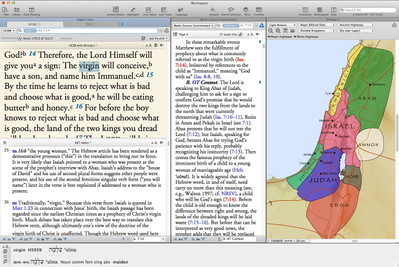This past Sunday, I taught my Sunday School class about the prophecy of Immanuel in Isaiah 7:14 and how Matthew applied that prophecy to the birth of Jesus in Matthew 1:22–23. That’s not as easy as it sounds if you’re trying to deal responsibly with Isaiah 7:14 in its original context.
All too often, Christians have read Isaiah 7 like this:
“Uh, ok … Isaiah is talking to some guy named Ahaz … umm, something about Aram and Ephraim and Rezin and some son of Remaliah … hmmm, when do we get to the part about Jesus?”
When they finally do get to the verse which speaks of a virgin conceiving, they forget about all those strange names and details and think Isaiah is suddenly shifting his attention to events which would not take place for another 700 years.
I wanted to correct this approach by teaching my class about the original context of Isaiah 7. That of course, means explaining that the Syrian kingdom of Aram and the northern Israelite kingdom of Ephraim had formed an alliance against the southern Israelite kingdom of Judah, whose king Isaiah was telling to trust God for deliverance. A map of these kingdoms is easily worth a thousand words, so I opened a Map in Accordance and chose Divided Kingdoms from the Region Layers pop-up menu.
After I had oriented them, we looked at the nature of the “sign” of the child named Immanuel, and I explained that this was a sign that God would deliver the people of Judah quickly. If they had to wait 700 years just to receive the sign, that would kind of defeat the purpose of Isaiah’s prophecy of deliverance! We then looked at the birth of this child and the fulfillment of the prophecy, which happens almost immediately in Isaiah chapter 8!
If all of this sounds confusing or is new to you, you’ll find a good explanation of what is going on in this passage in most commentaries or study Bibles. The NET Notes, which almost every Accordance user should have, does an excellent job with this, and Beale and Carson’s Commentary on the New Testament Use of the Old Testament is specifically designed to focus on these kinds of interpretive issues. My point here is not to get too embroiled in the details, but to show how Accordance makes teaching this kind of thing to an adult Sunday School class much, much easier.
By the time I had finished explaining the original context of Isaiah’s prophecy and had discussed the way Matthew applied this prophecy to the birth of Jesus, the folks in my Sunday School class were pretty excited. Most of them had never heard these things before, and far from being bewildered by a more complete reading of these passages, they were actually encouraged by it. One gentleman then asked me, “Is this taught in seminaries?” I think he was trying to figure out why he had never previously heard these things taught.
I answered that I think sometimes preachers and teachers are reluctant to correct our overly simplistic and out-of-context readings of well-known passages because they’re afraid they might upset people. Yet my Sunday School class was perfectly capable of accepting these things without any protest. I wonder if we aren’t sometimes selling our people short by assuming they’re not ready for more than a Christmas card-level interpretation of a passage.
Personally, I find that presenting my lessons using Accordance is always helpful when I’m challenging people to move beyond the shallow end of the interpretive pool. By showing them maps and passages on a projector screen, I give them something they can clearly focus on, which cuts down on the confusion that naturally accompanies having to unlearn long-held assumptions. I’d encourage any pastors and teachers out there not to be afraid to teach a deeper understanding of the Bible. Your people can handle it, and Accordance can help.


